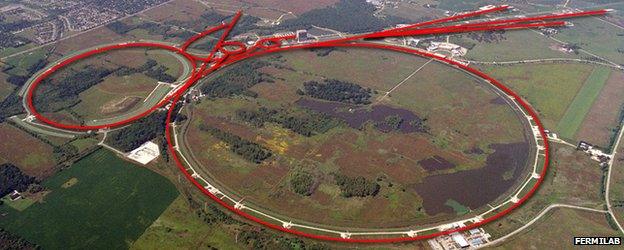Higgs boson hints multiply in US Tevatron facility data
- Published

The Tevatron led the high-energy physics world for two decades before its shutoff in 2011
Scientists from the US Tevatron accelerator say they have spotted possible hints of the Higgs boson at a mass similar to that seen at the LHC.
The findings add weight to the idea that the Higgs - purported to give all other particles their mass - exists near a mass of 125 gigaelectronvolts.
However, the new data are not themselves sufficiently statistically assured to rate the find a "discovery".
The results were presented at the Moriond physics conference in Italy, external.
The Tevatron, based at the US national laboratory Fermilab, was for two decades the world's premier particle accelerator, but was shut down in 2011 after negotiations to extend funding failed.
However, like all particle-smashers, the Tevatron created a tremendous amount of data that remained to be analysed.
The latest data hint at the existence of a particle between 115 and 135 gigaelectronvolts (GeV; this is between about 120 and 140 times as heavy as the protons found in every atom) with a certainty of about 2.2 sigma.
That means that there is about a one in 36 chance that the anomaly they see is the result of happenstance - far less assured than the "five sigma" threshold that physicists use to demarcate a formal discovery.
However, what makes the find more compelling is that the Large Hadron Collider has found a suggestive "bump" in its data at about the same mass, despite being a radically different experiment.
The LHC collides protons together, while the Tevatron used protons and their antimatter counterpart, antiprotons.
Both experiments hunt for the Higgs by looking at what those high-energy particles decay into.
At the Tevatron, the data are from the production of bottom quarks and their counterparts bottom antiquarks, whereas at the LHC the primary search is for the production of the light particles known as photons.
"It's a different accelerator, different detectors and a different decay channel," said Rob Roser, spokesman for CDF, one of the two main Tevatron detectors.
"It adds to the picture, and it's starting to make a compelling case," he told BBC News. "But we can't make quite as bold a statement as we would like.
"I just wish either one of us just had more data right now. It's frustrating."
The two main detectors at the LHC, CMS and Atlas, also presented results at the meeting on Wednesday, but the experiments have precious little further data relative to those presented late last year.
That will radically change later this year as the facility will produce three times the amount of data this year as in 2011.
However, recent analysis of Atlas data has "excluded" the mass range up to 122.5 GeV. The Tevatron data, meanwhile, exclude its presence at the heavier masses of 147-179 GeV, also completely consistent with what the LHC has found.
As has been said before, if it indeed exists, there are few places left for the Higgs boson to hide.
Tony Weidberg, a University of Oxford physicist who works at the LHC's Atlas detector, said that the Tevatron results were consistent with the idea of a comparatively "light" Higgs boson.
"It's interesting because it's another little hint," Dr Weidberg told BBC News. "It makes it a little bit more likely that we're going to end the year with a discovery rather than an exclusion.
"The proof of the pudding will be in the LHC data that we'll get this year; by the end of the year we'll have moved away from hints to either discovery or exclusion - and either of those results is exciting to me."
- Published4 July 2012
- Published13 December 2011
- Published30 September 2011
- Published7 April 2011
- Published29 February 2012